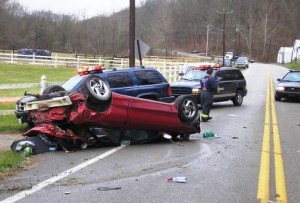Whether you credit cracking down on drunk drivers, the use of new technology or simply better-behaved drivers, highway fatalities have fallen to a half-century low, according to newly-released government data.
Any way you look at the numbers they’re good news. Total roadway deaths plunged 9.7%, last year, to 33,808, compared with 37,423 fatalities in 2008. The latest figures, according to the Department of Transportation, are the lowest since 1950. The highway death rate peaked in 1988 at 47,087.
And it’s significant to note that there were a lot fewer drivers on the road, six decades ago, clocking far fewer miles each year. Significantly, the 2009 DoT data show the highway death rate dipped to just 1.13 per 100 million miles driven. That’s down from 1.26 in 2009.
The news was received with a mix of optimism and caution. Consider it a “landmark achievement,” proclaimed Transportation Secretary Ray LaHood, but he went on to stress “We have a long way to travel” before achieving a goal laid out by the government – and a small but growing number of automakers – to achieve zero highway deaths.
Experts are debating the reasons behind the sharp decline in highway fatalities. The trend has come relatively steadily, over the past decade, and a decline in 2008 was linked, at least in part, to the spike in fuel prices, which led American motorists to curb their travel. But the further dip, in 2009, came even as people took to the roads again, the overall number of miles clocked by U.S. drivers rising 0.2% for the year.
LaHood suggested that the numbers may obscure changes in behavior, however. With money tight during the recession, he indicated people may be going out less, at night, to bars and other places where drinking can later promote reckless driving.
That’s backed up by a 7.4% decline in fatalities related to alcohol impairment – a total of 10,839 last year, down from 2008’s 11,711. Where as much as 60% of all highway fatalities involved alcohol in the early 1980s, that has been slipping to less than a third in recent years.
But alcohol-related deaths still rose in 17 states, the DoT pointed out.
Another sign of improved driver behavior is the finding that 85% of American motorists now buckle up. Research by James Madison University shows that belts reduce by half the likelihood of an accident-related injury, while fatalities decline by up to 70%. That translates into about 172 fewer deaths, the University reports, for every additional 1 point of belt usage.
Seat belt usage varies according to where motorists drive. About 10% more will buckle up on the freeway than on local roads, even though traffic fatalities tend to be lower, per 100 million miles, on limited access roadways. Belt usage also runs at least 10 percentage points higher – at 88% — in the growing number of states with primary seat belt laws. Such legislation allows a motorist to be ticketed for failing to buckle up. Other states either don’t mandate use of a seat belt or require a police officer to find evidence of another violation before pulling over an unbelted motorist.
While seat belt usage is considered one of the most effective ways to reduce injuries and fatalities in a crash, the decline in highway deaths is also being attributed to the introduction of other technologies – passive systems, such as airbags, which are designed to minimize injuries, and active technologies, like anti-lock brakes, which aim to help prevent collisions entirely.
A steady stream of new technologies has been working their way into the newest automobiles. But safety advocates also warn that some devices aren’t necessarily an improvement. Distracted driving is becoming a major concern. Cellphones, especially when used for texting, have caught plenty of attention. But advocate groups, like the AAA, have raised questions about such supposed advances as Lane Departure Warning, suggesting they may actually distract drivers or lull motorists into a false sense of security.
Nonetheless, some automakers, such as Volvo, have publicly stated a goal of driving highway fatalities down to zero in the decades to come, with new technologies playing a critical role.


Good report Paul,
I can’t help but comment on Sec. LaHood’s comment. Seriously, the government’s goal is “Zero” fatalities? Seems to me that is like saying “our goal is to someday have all pigs flying …” Sheesh.